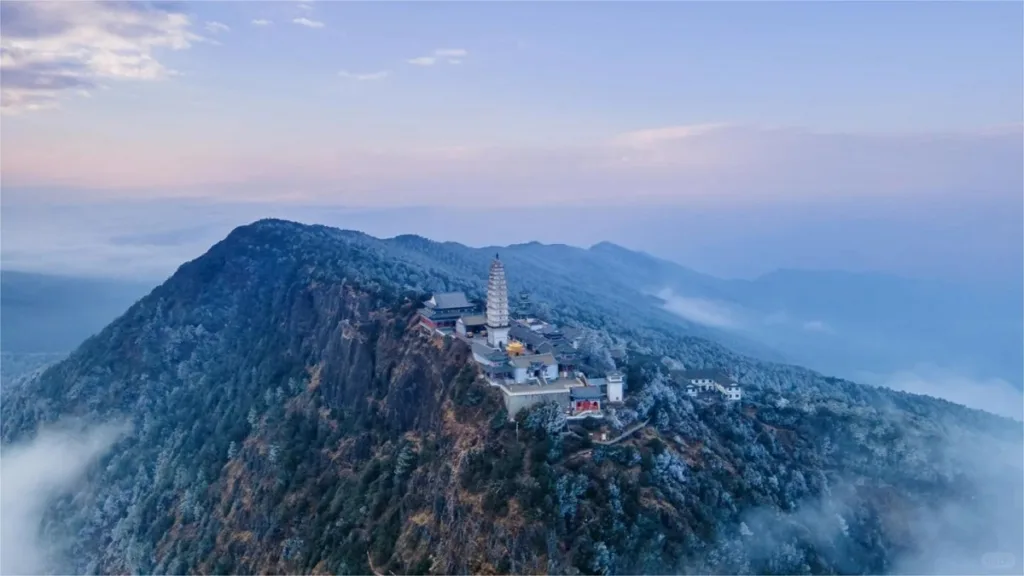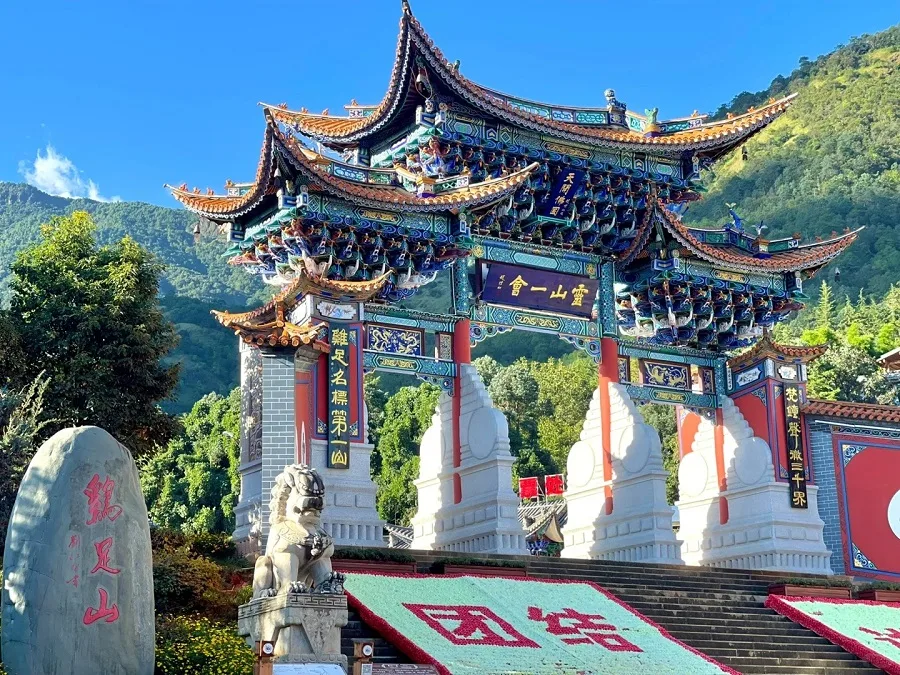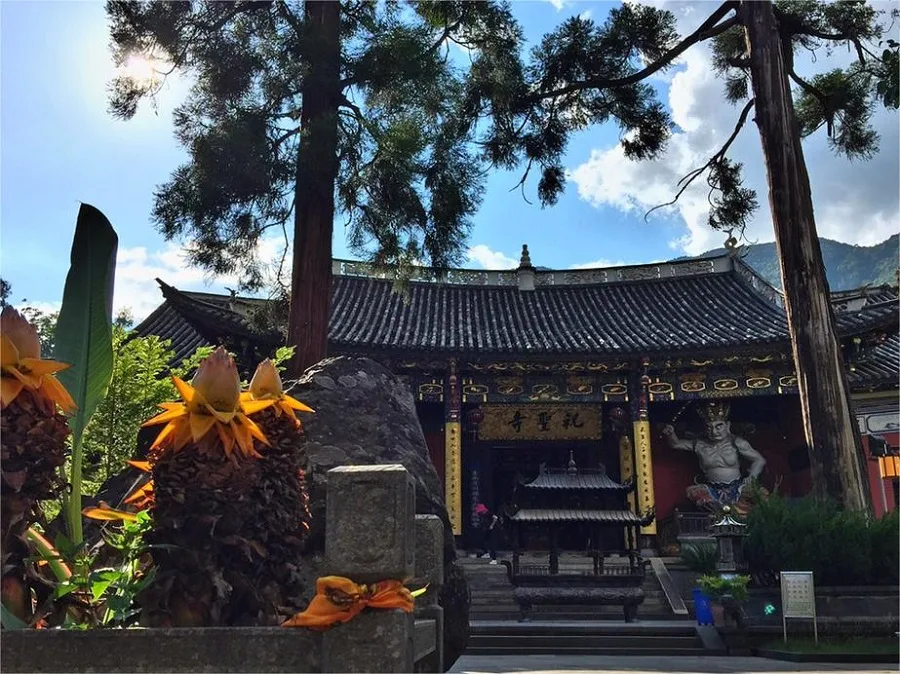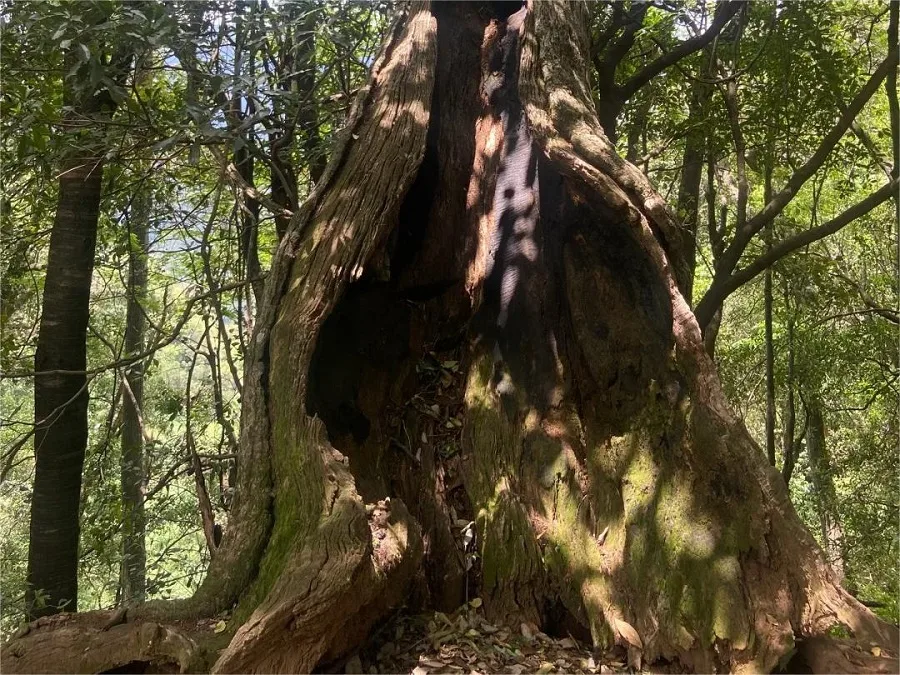Jizu Mountain, Dali – Ticket, Opening Hours, Location, and Highlights


Jizu Mountain (鸡足山, Chicken-Foot Mountain), also known as Jiuqu Mountain or Qingdian Mountain, derives its name from its resemblance to a rooster’s foot. Stretching 7 kilometers from east to west and 6 kilometers from north to south, it covers a total area of 28.22 square kilometers, with its highest peak, Tianzhu Peak (Golden Summit), reaching an elevation of 3248 meters above sea level. During the Song Dynasty, the monk Ciji practiced Buddhism here, leading to the rise of Buddhism on Jizu Mountain. During the Ming Dynasty, from the Jiajing to the Wanli reigns, there were hundreds of large and small temples on Jizu Mountain, accommodating thousands of monks and nuns. Taoism also entered Jizu Mountain during this time, with Taoist temples being built there. Today, it is considered a holy site for Buddhism in South Asia and Southeast Asia, as well as one of China’s top ten famous Buddhist mountains, believed to be the place where Mahakasyapa, the foremost disciple of Gautama Buddha, practiced.
Jizu Mountain boasts “eight major temples, thirty-four minor temples, and sixty-five hermitages,” including renowned temples such as Jindian Temple, Chuandeng Temple, Taizi Pavilion, Jiulian Temple, Jiaye Hall, Shizhong Temple, Jiguang Temple, and Huideng Monastery. In addition to temples, there are over 200 pavilions, halls, archways, and pagodas, as well as 18 bridges. During the first fifteen days of the first lunar month each year, the Chao Shan Festival (Mountain Worship Festival) on Jizu Mountain attracts a continuous stream of pilgrims, creating a lively atmosphere.
Inhoudsopgave
Basisinformatie
| Geschatte lengte van de tour | 1 dag |
| Ticket Prijs | 60 RMB |
| Kabelbaan | Omhoog: 45 RMB Omlaag: 30 RMB Return: 75 RMB |
| Gecombineerd ticket | Admission + Round Cable Car: 130 RMB Admission + Round Cable Car + Electric Car: 165 RMB Round Cable + Electric Car: 100 RMB |
| Openingstijden | 08:00-18:00 |
| Telefoonnummer | 0086-0872-7350020 0086-0872-7350496 |
Locatie en vervoer
Jizu Mountain is located northwest of Binchuan County in Dali Bai Autonomous Prefecture, Yunnan Province, China. To get there, you can choose one of the following ways:
By Car: Except during holidays like Spring Festival, National Day, and Labor Day, you can drive to Zhusheng Temple at the foot of Jizu Mountain.
Public Transportation: From Dali (Xiaguan) East Station, you can take a direct bus to Jizu Mountain or take a public bus from Xiaguan to Binchuan. Upon reaching Binchuan, transfer to a scheduled bus heading to Jizu Mountain.
Highlights of Jizu Mountain
Lingshan Yihui Archway

Standing at the foot of Jizu Mountain is the renowned Lingshan Yihui Archway, commonly referred to as the “Mountain Gate.” This archway, adorned with elaborate carvings and high eaves, serves as the boundary between the worldly and the pure land of Buddhism. Stepping through the archway is akin to entering a sacred realm, transcending into a realm of tranquility and spiritual purity. According to Buddhist tradition, over 2500 years ago, Gautama Buddha himself once preached here, attracting billions of celestial beings and humans to gather and listen to his teachings. Therefore, this place is revered by Buddhists as the Lingshan Yihui, meaning an assembly in Lingshan Mountain.
Pagoda Temple

Originally known as Zunsheng Pagoda Monastery, the Pagoda Temple is a significant site on Jizu Mountain. During the middle of the lunar month, when the bright moon aligns with the Tianzhu Peak, the Lingyan Pagoda, and the Zunsheng Pagoda, the surrounding forests become dimly lit while the two pagodas are illuminated by the moonlight, appearing solemn and serene.
The Zunsheng Pagoda, also known as the Shadowless Pagoda, is said to cast no shadow, believed to be a result of Princess Wencheng gently brushing away its shadow with a swan feather fan. Legend has it that Princess Wencheng and King Songtsen Gampo were deeply moved by the sincerity of Monk Wuming, who presented gifts on behalf of Jizu Mountain during their wedding. As a gesture of gratitude, they had this pagoda built on Jizu Mountain. On a moonlit Mid-Autumn night, as they strolled through the temple grounds, Princess Wencheng noticed that the pagoda’s shadow dimmed its beauty. With a gentle sweep of her swan feather fan, the shadow disappeared, leaving the pagoda bathed in the soft glow of the moonlight.
Stone Bell Temple

Built during the Tang Dynasty, the Stone Bell Temple is the oldest and most renowned temple on Jizu Mountain. Since the Ming and Qing Dynasties, scholars and dignitaries alike have been drawn to the Stone Bell Temple, leaving inscriptions and poetry. Dong Qichang, a prominent calligrapher of the Ming Dynasty, inscribed the plaque “薜萝居” for the meditation room in the Stone Bell Temple. Governor Wang Jiwen wrote the plaque “清梵普闻” for the temple, while Sun Yat-sen penned the banner “昙云法海.” Historically, the Stone Bell Temple has been a major center for Zen Buddhism. A Tibetan living Buddha visited Hua Shou Gate on Jizu Mountain to pay homage to Jia Ye and passed away in the Mahavira Hall after resting there. To commemorate him, a reclining Buddha statue was sculpted at the spot where he passed away, and since then, Tibetan believers have regarded the Stone Bell Temple as a pilgrimage site for Tibetan Buddhism.
Zhusheng Temple

Originally named Yingxiang Temple and also known as Boyu Monastery, Zhusheng Temple is the largest temple on Jizu Mountain, established during the Jiajing reign of the Ming Dynasty (1522-1566). Situated against the mountainside, Zhusheng Temple exudes grandeur and elegance, with its spacious layout, red walls, and green tiles creating a picturesque scene. The architectural style of Zhusheng Temple reflects the distinctive characteristics of Yunnan Bai ethnic architecture, featuring a pond for releasing animals, an octagonal pavilion, the Mahavira Hall, the scripture repository, the treasure house, the Rain Flower Terrace, and four halls on both the east and west sides. The temple is adorned with corridors, gardens, stone benches, tea seats, and bamboo groves, creating a serene and picturesque environment.
Hollow Ancient Tree

Among the ancient trees on Jizu Mountain, one of the most remarkable is the Hollow Ancient Tree, located near the ruins of the original Xitan Temple along the mountain trail. This tree has stood for over 1700 years. It belongs to the high mountain oak species, standing 18 meters tall with a basal diameter of 4.5 meters, requiring seven to eight people to encircle it. The cavity inside the tree has a diameter of 2.7 meters and a height of 3.5 meters, with enough space to accommodate around 20 people. It even contains a niche for offering to the Buddha. According to records, during the Ming Dynasty, the venerable monk Ruzheng once meditated and resided in this cavity for over forty years.
Jade Dragon Waterfall

The Jade Dragon Waterfall exhibits different forms depending on the season, offering varied scenic views throughout the year. During the summer and autumn rainy seasons when the mountains are lush with water, the Jade Dragon Waterfall cascades down like flying flowers splashing jade, enveloped in mist and spray. On sunny days, when the sunlight hits the mist, it creates several rainbows surrounding the pristine waterfall. As winter arrives and the mountains grow cold while the water diminishes, the waterfall gradually shrinks, displaying a serene and picturesque landscape resembling an ink painting. Thin streams meander down the cliffs, resembling white ribbons gently swaying in the breeze.
Jiaye Hall

Originally named Jia Sha Hall, Jiaye Hall is steeped in historical significance. According to ancient records, during the reign of King Ling of the Zhou Dynasty in 565 BC, the Buddhist founder Sakyamuni was born, and his robe was said to be enshrined here. Hence, it was named Jia Sha Hall. During the Tang Dynasty (742-756 AD), a sandalwood statue of Jiaye carved by Ananda was enshrined here, leading to its renaming as Jiaye Hall. In the Chan (Zen) Buddhist tradition of China, Jiaye is revered as the patriarch who inherited the profound essence of Nirvana, embodying the ideology of Chan Buddhism. In recent years, Jiaye Hall has been newly renovated, presenting a refreshed appearance. It comprises three main halls: the Maitreya Hall, housing statues of Maitreya Buddha and the Four Heavenly Kings; the Guanyin Hall, dedicated to the Thousand-Armed Guanyin; and adorned with murals depicting the scene of the “Lingshan Assembly.” Adjacent to the south side of Jiaye Hall is the Ancestral Hall (also known as the Quadruple Hall), housing a statue of Sakyamuni Buddha, along with murals depicting Sakyamuni and his disciples, as well as the Eighteen Arhats.
Golden Summit Temple

Founded in the Ming Dynasty, the Golden Summit Temple has a rich history. Even before the Ming Dynasty, there was already a square pagoda. During the Jiajing reign (1522-1566), Li Yuanyang built the Puguang Hall. In the 28th year of the Wanli reign (1600), the Brightness Treasure Pagoda was constructed. In the 47th year of the Wanli reign (1619), the Guanfeng Pavilion was built, followed by the Tianchang Pavilion during the Tianqi reign. In the 10th year of the Chongzhen reign (1637), the Shanyu Pavilion was erected, and a protective wall was built around it, along with gatehouses for viewing, giving rise to its name “Four Observatories.” Later, the Taihe Bronze Palace from Yingwu Mountain in the eastern suburbs of Kunming was moved to the top of Tianzhu Peak by Mu Tianbo, the Duke of Qian, hence the name Golden Summit Temple. In the 21st year of the Republic of China (1932), Long Yun, Chairman of the Yunnan Provincial Government, responded to the request of the monks to rebuild a pagoda on the original site of the Brightness Pagoda. Legend has it that during construction, a copy of the “Shurangama Sutra” was discovered underground, hence its name Shurangama Pagoda. This square pagoda, standing at 42 meters tall with seven internal levels and thirteen external levels, is a prominent feature of the temple complex.
Dali bezienswaardigheden, Yunnan landschappen